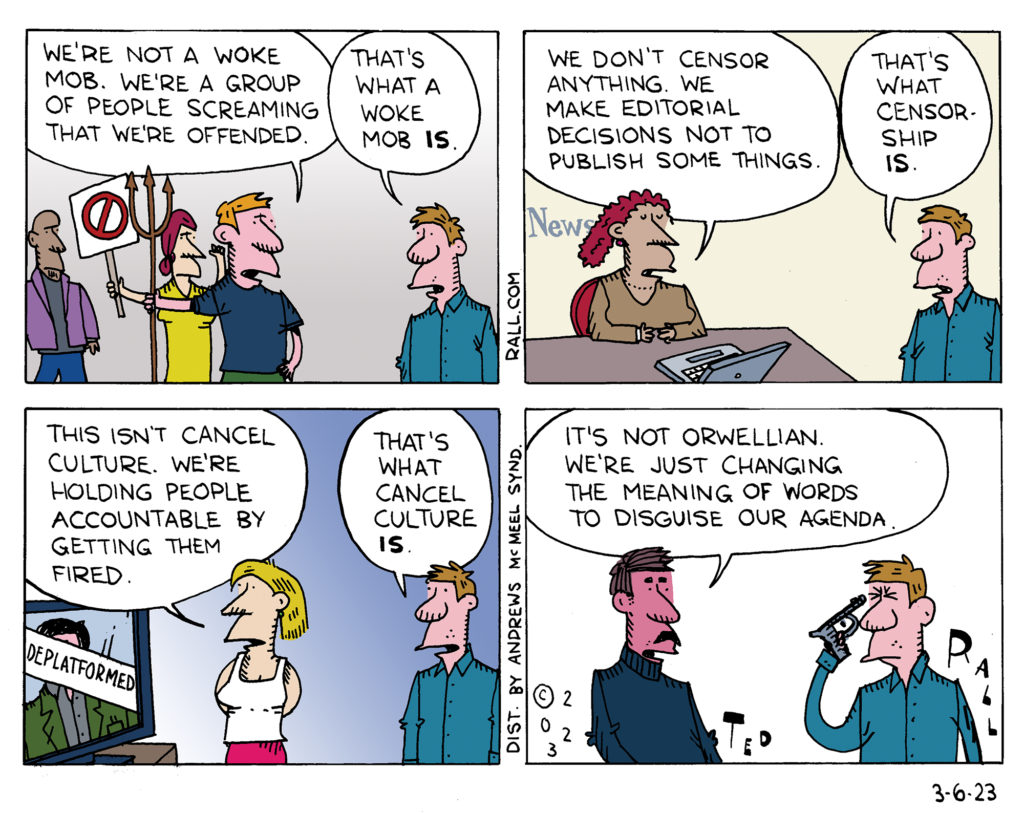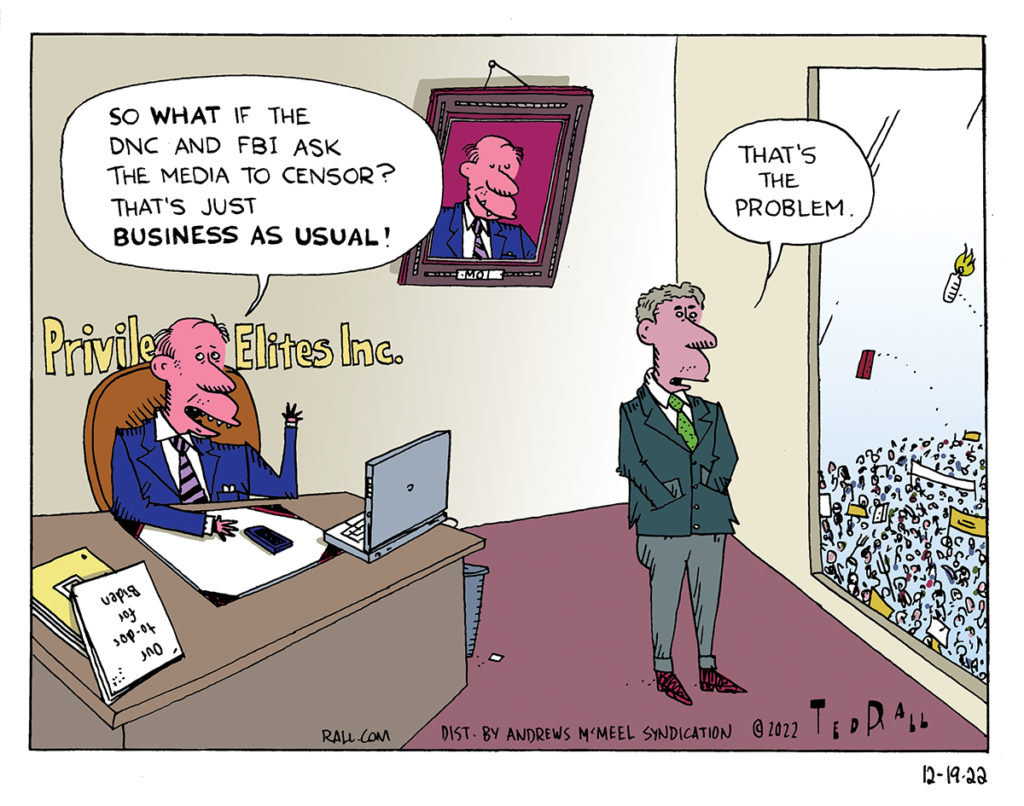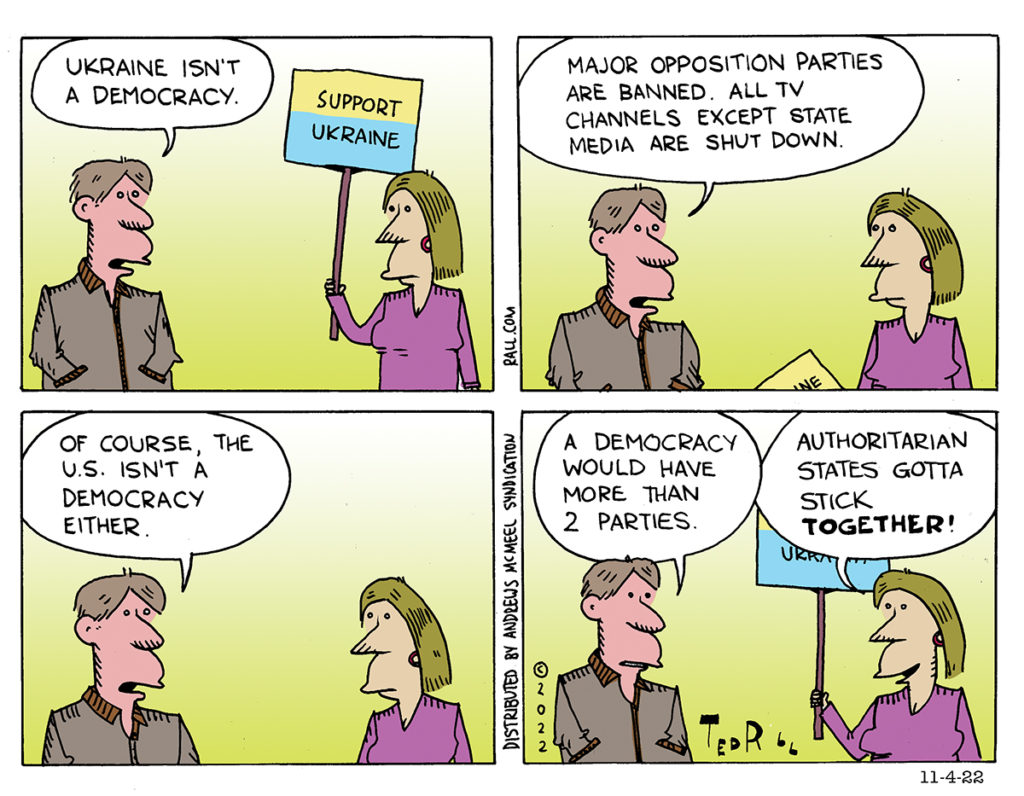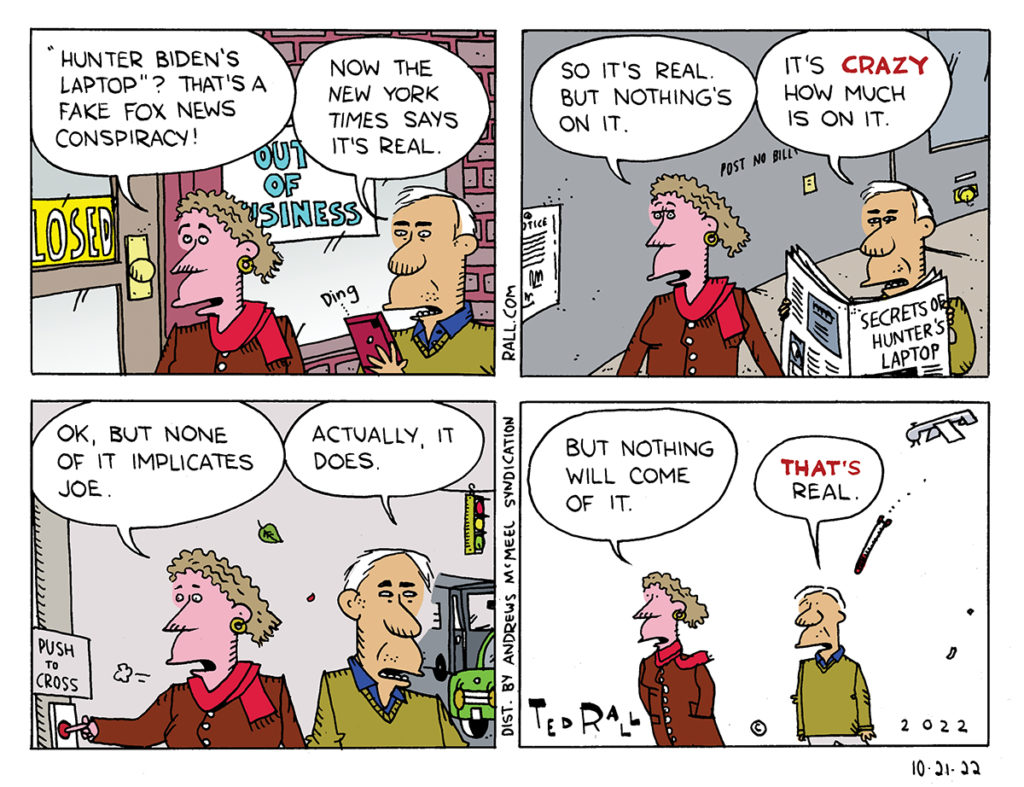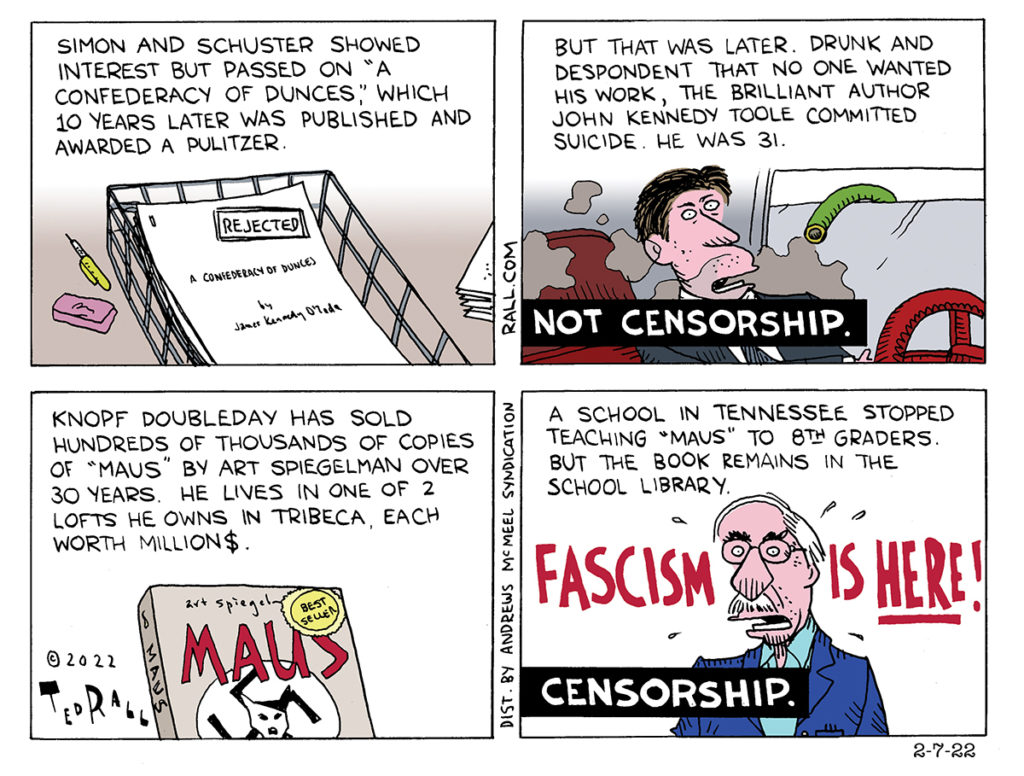Controversy that followed race-baiting by cartoonist Scott Adams that led to the cancellation of the iconic comic strip “Dilbert” included numerous people denying the meaning of words and terms involved. Those who were angry and wanted action against him. But they didn’t want to be seen as taking action.
Either the President Is a Terrorist or a Journalist Is a Fraud. Why Doesn’t Anyone Want To Find Out Which Is True?

Corporate ownership of media outlets and consolidation have deteriorated the quality of reporting in numerous ways: accelerating access journalism, gutting local news and investigative reporting, a decreasing willingness to take chances or to invest in projects without a quick return on investment.
Now there’s a new problem, one so baked into the equation that we should have seen this coming all along: newspapers and other media organizations acquired by corporations are themselves acting like corporations.
For an earlier generation of journalists, ignoring a major news event after it broke at another outlet was out of the question. The movies “All the President’s Men” and “The Post” depict the rivalry between the New York Times and the Washington Post as they crosschecked one another’s scoops on Watergate and the Pentagon Papers, and built on one another’s reporting. Despite pressure to the contrary from their friends at the highest levels of the political and financial establishment, publishers Arthur Sulzberger and Meg Greenfield set aside their usual caution and helped bring down President Nixon. They worried about repercussions but the news always came first.
This culture didn’t always play out to the benefit of journalism’s ostensible endless quest for truth. Reporter Gary Webb, who broke much of the 1980s Iran-Contra scandal in the pages of the San Jose Mercury News, was attacked by major competitors who nitpicked his writing to death in a “tawdry” campaign to discredit him over minor errors, by the Post, Times and the Los Angeles Times. Webb was basically right—but they destroyed him and his career, pushing him to commit suicide.
In the aggregate, however, reporters’ drive to learn more and do better served readers well.
Unlike a news organization, in which uncovering the truth whatever it may be is the prime directive, a corporation’s mission is first and foremost to maximize profits to shareholders. So corporate news organizations put revenue first as well. Reporting has been pushed down the list.
Most major news organizations are owned by people and parent companies with far-ranging interests that conflict with news gathering. The formerly family-run Post is now owned by Jeff Bezos, whose Amazon cloud business has billions in secret contracts with the NSA and CIA; would he let his pet newspaper mess up his cozy relationship with the White House and the deep state by kneecapping the president?
Bezos’ massive conflicts of interest may not be the sole reason the Post hasn’t touched a blockbuster story: Seymour Hersh’s allegation that President Joe Biden personally ordered one of the biggest acts of state terrorism in modern history, the bombing of the Nord Stream 2 natural-gas pipeline. But it’s a safe bet they are a contributing factor.
Under normal circumstances, or more accurately the circumstances that prevailed in the previous century, a detailed allegation written by the legendary Pulitzer-winning reporter who exposed the My Lai massacre and the Abu Ghraib prison abuse scandal, that a sitting president risked World War III and allowed Europeans to freeze—not to mention deliberately created a massive environmental disaster—would be a bombshell no reputable news outlet could ignore—indeed, they’d run with it, try to verify it, build upon it, comment upon it. Instead, there has been a near 100% U.S. media blackout. If it wasn’t so Orwellian you’d have to be impressed by how thorough and disciplined the effort to quash Hersh in a vacuum of obscurity has been.
I’ve been running Google News searches on Hersh and Nord Stream every day since the story broke about a week ago. No big-name U.S. newspaper, radio network or cable news channel has mentioned it, not even to say it’s false.
None.
Unless you are a news geek of epic proportions it’s unlikely that you would have noticed one of the few mentions in right-wing sources like the Murdoch-owned New York Post, the Washington Times and Fox’s Tucker Carlson, which can’t resist anything that bags on the president, or a blog like New Left Review, UnHerd and Firstpost. Times, Post, NPR, CBS—nada.
It’s entirely possible that Hersh is partly or totally wrong about how the pipeline was bombed and who was responsible. What arouses suspicion that he’s right is the militant incuriosity of the press. You can’t even find an op-ed speculating on who might have done the deed.
The West initially and hilariously blamed Russia, which co-owns the pipeline, for blowing up its own multibillion dollar property. That story quickly fell apart.
So who did it? You’d think some enterprising reporter would try to find out—but you’d be wrong. Hersh’s story relies on a single anonymous source. But at least he’s got a source and a willingness to quote them. That’s more than anyone else. Meanwhile the Biden Administration has not categorically denied involvement—Washington-speak for we 100% didn’t do it. Back in the not-so-old days, that would make many an ink-stained wretch’s ear perk up.
I’m with my former colleague Mark Ames: “If anyone has a more convincing story then come out with it, show us the goods,” he says.
No matter the outcome, a reporter who proved what really happened a few hundred feet under the North Sea would score a delicious scalp: Biden’s or Hersh’s. Either the president is a war criminal who should be arrested immediately or a gadfly journalist has become a lying hack to whom no one should pay attention. Which is it? No one in American corporate media seems to want to nail this generation’s Nixon….or Gary Webb.
Why not?
A free press has the right to print or not print anything as it pleases. But the decision of thousands of editors and producers not to touch Hersh’s pipeline story doesn’t feel like a coincidence or such an easy call as to be unanimous. It feels like a hard chill.
Media critic Robert Wright thinks the self-imposed blackout remains in force because the (sorry) explosive truth might undermine U.S. political, corporate and media support for Ukraine: “Not even using the Hersh story as an occasion to revisit the question of who blew up the pipeline (which they could have done even while treating the Hersh story skeptically)—are more evidence of how committed much of the elite media now is to serving the official American narrative [on the Ukraine war],” says Wright.
It’s also a reflection of corporate ownership of the media. When a corporation faces bad or inconvenient news it refuses to comment, counting on the American people’s infinite vulnerability to the distraction machine.
(Ted Rall (Twitter: @tedrall), the political cartoonist, columnist and graphic novelist, co-hosts the left-vs-right DMZ America podcast with fellow cartoonist Scott Stantis. You can support Ted’s hard-hitting political cartoons and columns and see his work first by sponsoring his work on Patreon.)
DMZ America Podcast #77: Twitter Files Hunter Biden, Gender Transition for Kids, What to Do about Kanye West
Political cartoonists Ted Rall and Scott Stantis, coming from the left and the right respectively, analyze the fallout from the weekend’s media dump at Twitter. Not only was the Hunter Biden laptop story real, censorship of the New York Post was worse than you imagined. Should children be able to change their gender surgically or otherwise? Adults attempting to detransition are forcing a reevaluation. Finally, what’s the best way to deal with Kanye West?
Us Dictatorships Have To Stick Together
Supporters of Ukraine keep saying that it’s a democracy. But it’s not. President Zelensky has banned rival political parties and shut down all media outlets except for official state media that supports him. On the other hand, the United States doesn’t really have much democracy to brag about either.
The Left Must Continue to Avoid the Ukraine Trap
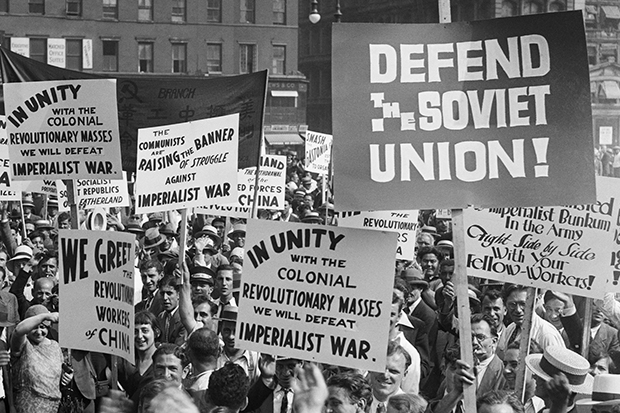
“Find a way to be against the war in Ukraine, please.” That was the subject line of one of my recent hate emails. “If you look through Mr. Rall’s cartoons for the past month, there isn’t a single one condemning Russia’s invasion of Ukraine,” an anonymous online commentor chided. “There’s plenty of ones based around whataboutism condemning us for condemning them but not a single one that just comes right out and says what Russia is doing now is wrong.”
The Right—in the U.S. that includes Republicans, Democrats and corporate media—has set a clever trap for the antiwar Left. The rhetoric in this essay’s first paragraph is an example. If the Left were to support Russia’s invasion of Ukraine, the Right would portray us as Russia-loving hypocrites who only oppose wars when the United States starts them. If the Left backed Ukraine, they’d be joining an unholy alliance with a government installed in a CIA-backed coup, that pointlessly provoked Russia by asking to join NATO and is so tolerant of neo-Nazism that it allows soldiers wearing Nazi insignia in its military and is seems to be trying to set some sort of record for building statues to World War II Nazi collaborators and anti-Semites. Plus they’d be helping the Right distract people from the murderous sins of American imperialism, which are ongoing.
Stuck between these two unappetizing prospects, the Left has wisely chosen not to pick sides. Instead, we are pointing out that militarily-aggressive America is too hypocritical to criticize Russia—a stance the Right describes as “whataboutism.”
So the Right is trying to force us to choose sides.
Free speech used to include the right not to speak. No more. New York’s Metropolitan Opera, wallowing in cheap post-9/11-style neo-McCarthyism, fired star soprano Anna Netrebko, a Russian national, because she refused to condemn Russian President Vladimir Putin, and replaced her with a Ukrainian. This was after she criticized the invasion. A Canadian concert canceled an appearance by pianist Alexander Malofeev because the program’s artistic director claimed he could not “in good conscience present a concert by any Russian artist at this moment unless they are prepared to speak out publicly against this war.”
Cancel those who refuse to regurgitate the words we stuff down their throats! Cancel them all!
I refuse to be told what to think and what to say, particularly by the Right. That goes double when the matter involves a complicated foreign policy crisis. I need time to dig into the facts, double- and triple-check and consider where I stand. Whether a hard sell emanates from a realtor, car salesperson or editorial writer at a newspaper, anyone who tries to bully me into a quick decision in their favor gets my freezing-cold shoulder. Threats and ultimata get nowhere fast.
To the extent that anyone should care about Ukraine, they’re in good hands with the Right, which is covering up Ukraine’s neo-Nazis and their ethnic cleansing of the Roma, sending them billions of dollars in cash and weapons and risking thermonuclear war by threatening regime change against Russia. Ukraine doesn’t need the Left too.
We on the Left do not owe anything but ferocious opposition to the political and media establishment that gave us the Afghanistan and Iraq wars. These are the same scum who legalized torture, kneecapped Bernie Sanders and insist that only rich people should be allowed to see a doctor. The Right never helps us, or our overseas allies. If they want to festoon social media and office buildings with Ukrainian flags, let them do it without us.
Any leftist who publicly expresses support for Ukraine and/or criticizes Russia in the current media environment, awash in imperialist propaganda at a fever pitch, is a rube, a dupe, an idiot. A leftist who takes even a second of attention away from the U.S.-created famine in Afghanistan gives aid and comfort to gangster capitalists and allows the butchers of Guantánamo and Fallujah and the Salt Pit to get off scot-free. Jumping on the Ukraine war bandwagon would be the height of tactical foolishness and a betrayal of the fundamental values of the Left.
For the Left, change has to begin here at home.
American leftists are citizens of the wealthiest nation on earth, its biggest and most aggressive military power, backer of the most important currency and, since 1945, so influential that it unilaterally decides whether a place is to be internationally recognized as a nation-state and whether or not its government is legitimate. Whether directly in countries like Vietnam, Panama and Bosnia or by proxy in conflict as in Syria, Yemen and Somalia, the United States has been a key player in almost every major war in the world for decades. The total death count attributable to U.S. forces and proxies in illegal and unjustifiable wars is incalculable, but it numbers in many millions.
The United States starts and prolongs more wars of choice than any other country. Leftists who live in the United States therefore have a special responsibility to work to destroy our country’s cult of militarism.
This is not to say that the Left cannot or should not have opinions about distant conflicts and foreign policy dilemmas on the other side of the planet. It’s a matter of priorities — when you live in a country as powerful and influential as the United States, it makes more sense for the domestic Left to marshal its resources to protest and campaign against America’s own actions as an empire than to worry about, say, China possibly invading Taiwan.
At this writing the United States is backing Saudi Arabia in its brutal campaign in Yemen. The reprehensible torture and detention camp at Guantánamo Bay remains open. Palestinians in Gaza continue to suffer under occupation by Israel, a staunch U.S. ally. Afghans are starving to death in large part because the United States refuses to release Afghan government money to the new Taliban government. These atrocities are directly attributable to the United States.
The more we think and talk about Ukraine, the less we work on our own country, which we have a much better chance of changing.
Rallies and protests directed at your own country, from inside your own country, are infinitely more effective than those that take place overseas. Millions of people marched against invading Iraq in 2003 all over the world. Even though the Bush administration ultimately went to war, the Americans who stood up against their own government right here got far more attention in Washington. The Right’s warmongers didn’t care what the French or the Japanese thought, and why should they?
Conversely, there were hardly any major protests against the invasion and occupation of Afghanistan in the United States, though there were many overseas. The Afghan war probably would have ended sooner if we Americans had demonstrated in a sustained way.
The Left is concerned about many issues. So one of our biggest enemies is distraction. As the 1950s civil-rights song goes, keep your eye on the prize! Police violence, veterans committing suicide, healthcare, the income gap, climate change, homelessness, and a Congress that spends billions of dollars on weapons for Ukraine while kids go into debt to attend college are problems that no one but the Left is going to care about, much less try to fix. Russia’s actions in Ukraine are a big fat distraction on the other side of the planet at a time when we have a lot to do right here at home.
(Ted Rall (Twitter: @tedrall), the political cartoonist, columnist and graphic novelist, is the author of a new graphic novel about a journalist gone bad, “The Stringer.” Order one today. You can support Ted’s hard-hitting political cartoons and columns and see his work first by sponsoring his work on Patreon.)
Why I Work for Sputnik
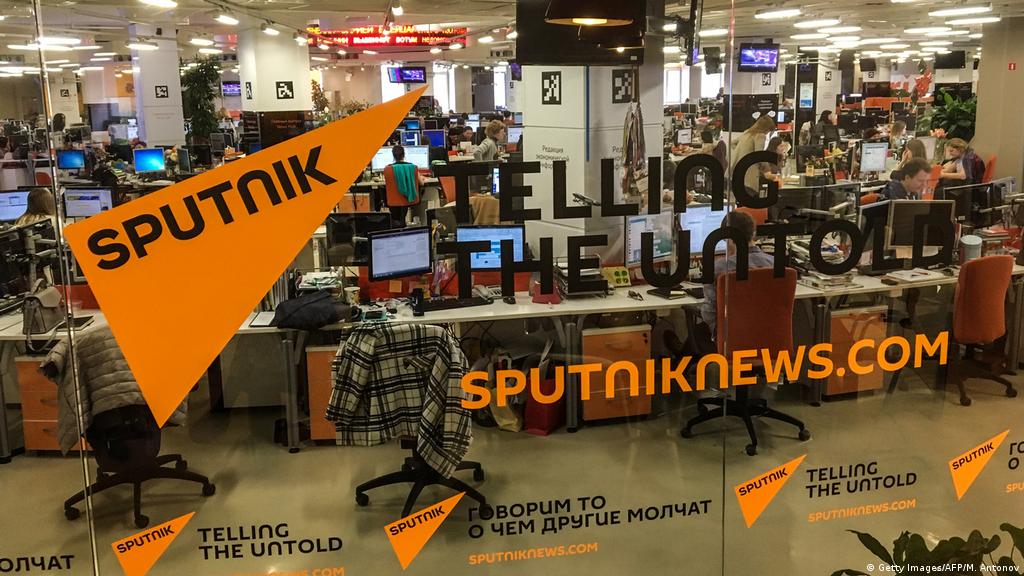
I have won two Robert F. Kennedy Journalism Awards, been a Pulitzer Prize finalist, published more than 20 books and have seen my political cartoons and columns appear in hundreds of newspapers and magazines. So why do I have Russian state media as one of my clients?
I’m on Sputnik News’ website—as a freelancer, not on staff—and a frequent guest on its radio feed for the same reason that former New York Times war correspondent Chris Hedges and former MSNBC talk host Ed Schultz appeared on the now-shuttered RT America television network:
I’m a leftist.
It’s an article of faith that the United States is a conservative country. But 38% of American voters prefer socialism to capitalism. That’s a remarkable figure considering this country’s history of suppressing the Left from the Palmer raids to McCarthyism to the methodical legislative destruction of trade unionism.
The American Left is bigger than you may think, and it’s growing. Yet leftist voices—antiwar, anti-capitalist, militantly environmentalist—are nowhere to be found in the mainstream, corporate-owned print, broadcast and online news media outlets consumed by the vast majority of U.S. citizens.
It doesn’t matter how entertaining or relevant or smart or funny you are. Communists, socialists, anarchists, left libertarians, deep-green environmentalists and populist progressives need not apply as opinion columnists, radio or television commentators. There isn’t even space in mainstream media for pundits who align with establishment progressives like Senators Bernie Sanders and Elizabeth Warren, whose ideas are indistinguishable from old-school liberal Democrats like Hubert Humphrey and George McGovern.
Fortunately, some leftists found a home on RT or Sputnik. Conservative critics often accused them of being mouthpieces for the Russian government. But that’s not my experience of the Americans I know. They had their own opinions and found a platform where those opinions were welcome.
Working for Sputnik puts a target on your back. Even though I’m not on staff, Twitter and Facebook label links to my Sputnik cartoons as Russian state media. And in the current atmosphere of hysteria over the Russia-Ukraine war to which the U.S. isn’t even a party, reactionaries tar me with that 1950s Cold War classic, guilt by association. Just this week, for example, another cartoonist had the nads to call me “a traitor to American ideals and to democracy,” “Putin’s puppet, a Kremlin propagandist, and a useful idiot.” If this were the 18th century, I’d demand satisfaction from the cur.
Useful idiot, of course, is an insult popularized by fascists during McCarthyism. It is still used by the extreme right.
I’m curious: what would this neoconservative, who was in favor of invading both Afghanistan and Iraq and now wants another stupid war in Ukraine, have people like me do? Sit in silence forever?
Apparently, yes. If you’re on the “actual left,” with a worldview influenced by Marxist class analysis rather than identitarianism, no amount of talent or popularity will get you on the airwaves or into “respectable” print. Until last week, if you were a lucky leftist, you’d be invited to host a show on RT or appear as a guest, where—unlike on CNN, MSNBC or Fox—you’d be treated with respect, asked intelligent questions and given time to answer them.
Is it really possible that there are no insightful communist economics experts? No funny socialist editorial cartoonists? No sharp, telegenic, anarcho-syndicalist TV commentators? Of course such mythical creatures exist—they appeared on RT and, before it was deplatformed by Comcast and DirecTV in 2016, Al Jazeera America. The real reason for the Left’s lack of representation in mainstream media, one suspects, is ideological discrimination.
If “democracy dies in darkness,” as The Washington Post’s motto reads, why not allow all ideas to be discussed openly?
Even cable TV’s most “liberal” channel refuses to air content to the left of the center of the Democratic Party. MSNBC fired left-leaning political talk host Phil Donahue in February 2003, at the peak of the build-up to the invasion of Iraq even though he had the highest ratings of any program on the network. Bosses blamed production costs. But an internal MSNBC memo worried that Donahue presented a “difficult public face for NBC in a time of war,” and provided “a home for the liberal antiwar agenda at the same time that our competitors are waving the flag at every opportunity.”
“They were terrified of the antiwar voice,” Donahue recalled.
Twelve years later MSNBC fired feisty pro-worker talker Ed Schultz. He claimed that they fired him for insisting upon covering Bernie Sanders’ 2015 campaign launch speech. “You’re not covering Bernie Sanders,” network president Phil Griffin ordered Schultz.
“I think that they were in the tank for Hillary Clinton, and I think that it was managed, and 45 days later I was out at MSNBC,” Schultz who died in 2018, remembered. Like other exiled lefties, Schultz landed at RT. “There was more oversight and more direction given to me on content at MSNBC than there ever has been here at RT,” he added.
RT’s diverse team of commentators wasn’t limited to leftists. The roster included Hedges, WikiLeaks founder Julian Assange, former Minnesota governor Jesse Ventura, “Star Trek” actor William Shatner, ex-CNN host Larry King, leftist comedian Lee Camp and right-wing pundits Dennis Miller and Steve Malzberg. Guests included academic experts, political activists and politicians like former Green Party presidential candidates Ralph Nader and Jill Stein, both of whom were marginalized by U.S. news media and denied spots in presidential debates.
The small sliver of American viewers who gave RT a chance encountered excellent production values and high-quality news and opinion programs that didn’t talk down to the audience. RT was unpredictable, entertaining and frequently more engaging than the three major cable news channels. It was nominated for five Emmys.
Critics of RT and Sputnik, however, have complained that RT shines a spotlight on schisms in U.S. politics and society, for example “push[ing] divisive racial narratives, including stories emphasizing allegations of police abuse in the United States and highlighting racism against African-Americans within the military,” as The New York Times wrote in 2020. Since when, however, is the U.S. or any other government entitled to positive news coverage? If racism makes America look bad, don’t eliminate coverage of racism—eliminate racism.
Opponents also deride RT and Sputnik’s news coverage as Russian government propaganda. Which is, of course, objectively subjective.
On RT/Sputnik as on other outlets, bias is largely a matter of omission. In my experience what runs on Sputnik is fact-checked. But it shouldn’t be anyone’s go-to source for criticism of Russian President Vladimir Putin, any more than you should look to MSNBC for harsh takes on Joe Biden or Fox for sharp attacks on Donald Trump. One could argue, and many on the Left have, that “respectable” American news outlets have frequently worn their biases on their sleeves often, and are often accused of disseminating propaganda. The absence of thoughtful antiwar voices during false WMDs claims during the run-up to the invasion of Iraq and denying coverage to Bernie Sanders come to mind.
RT America shut down last week after it was deplatformed by Roku, DirecTV and cable networks in response to Russia’s invasion of Ukraine. Before it went dark on television, it had earned a sizable online audience. In 2013 the channel became the first to reach 1 billion views on YouTube, numbers driven in part by its willingness to cover third-party candidacies that no one else would touch and round-the-clock reporting on the Occupy Wall Street movement.
The leftist Australian blogger Caitlyn Johnstone has frequently remarked that RT America and Sputnik News would have become instantly unviable had left-leaning voices been invited onto mainstream American media outlets. “There’s this bizarre, stupid notion people have accepted that socialist and antiwar voices should never allow Russian media to platform them, and should instead wait until they are given a large platform by Western mainstream media, and keep waiting, and waiting, and just keep on waiting until we all die in a nuclear holocaust,” Johnstone wrote. “If you have something important to say and you know it’s a true and helpful message, then it doesn’t matter if it’s the Russian government who’s giving you your platform or anyone else, because the message itself is intrinsically valuable.”
I agree. When I tell friends that I’m on Sputnik News, an online radio service and news site accessible via the web and therefore less vulnerable to Ukraine-related cancellation in the United States than in Europe, where it is banned, some cock their heads and give that “Really?” expression. Those who check it out are impressed, surprised that the overall tenor of discussion is smarter and sharper than, say, NPR. Sputnik is still operational, with 57 million visits online in the last month. They grant me a platform for my ideas, which are discussed by an appreciative, well-informed audience. They don’t censor me. And they pay.
Until the revolution destroys capitalism, leftists must compromise their principles in order to survive. I’ve never been published by a media organization with which I shared all of my political ideals. As a realist with bills to pay, where would I find a media organization with which I share most of my political ideals? I disagree with Sputnik about various issues; I also disagree with NPR and even with Jacobin, the socialist magazine.
I would work for pretty much any media outlet that doesn’t constrain my freedom of expression beyond what I consider reasonable limits. (Sputnik has never told me what to say, which is more than I can say for many of my other clients.) But over the past 20 or so years, the media has been turning farther and farther to the right. Left voices, especially before 9/11, were occasionally allotted space alongside liberal Democrats on the opinion pages. I was one of them. Leftists sometimes appeared on cable news television. Again, I was one of them. So was Rachel Maddow. She survived, and thrived, by moving right into mainstream liberalism.
That tiny sliver of openness has vanished. Anti-interventionists rarely if ever—I would say never, but I can’t watch 24-7—appear on those panels of talking heads who discuss foreign policy crises; the acceptable range of discussion runs from pro-interventionist to more pro-interventionist. When is the last time you heard anyone on cable news suggest that the U.S. ought to stay out of an overseas hot spot entirely, that it’s not our business?
All the Left needs for a fair shot at readers and viewers is one angel investor. But millionaires tend to dislike socialism. George Soros, bête noir of the right, funds Democrats, not lefties.
This piece was submitted to The New York Times and The Washington Post. Both rejected it.
For leftists, Sputnik is still one of the few games in town.
(Ted Rall (Twitter: @tedrall), the political cartoonist, columnist and graphic novelist, is the author of a new graphic novel about a journalist gone bad, “The Stringer.” Order one today. You can support Ted’s hard-hitting political cartoons and columns and see his work first by sponsoring his work on Patreon.)
Censorship | Not Censorship
The decision of a Tennessee school board to remove a graphic novel about the Holocaust from the eighth grade curriculum has many people crying censorship. But what really is censorship? Why do we not consider economic censorship, the decision not to print something in the first place, less severe than something like this Tennessee decision? Better, after all, to have been printed and sold than to have never been printed and sold.
How Liberals Censor Leftists
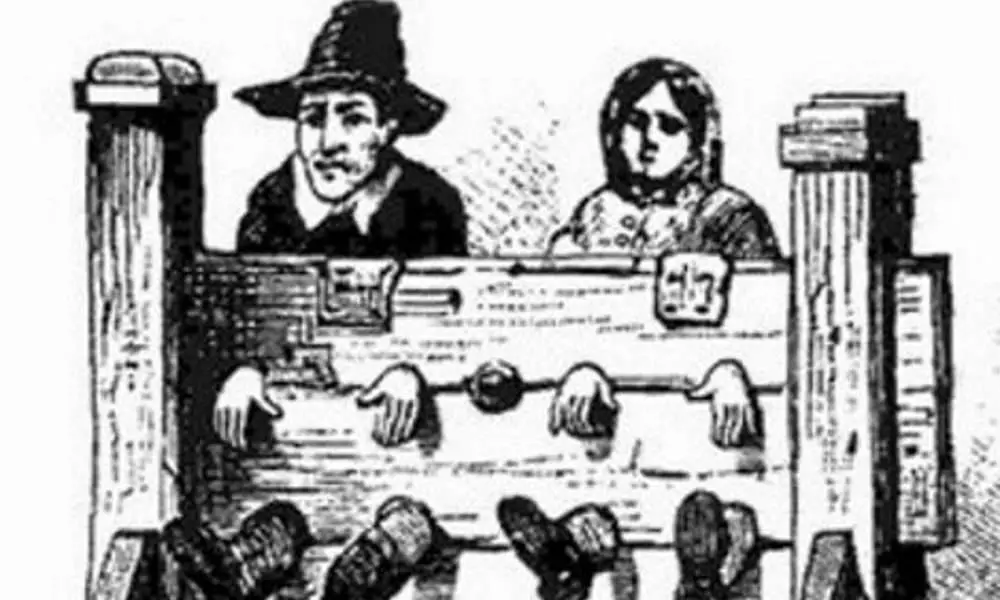
Just a few decades ago it was still possible for the left to find space on corporate-owned airwaves. Progressive talkers like Tom Leykis, Lynn Samuels and Phil Donahue found wide audiences until they got pushed off the air by the corporate powers that be. I worked talk radio in Los Angeles and San Francisco until 2007.
The same applies to print. Until the 1990s the New York Times occasionally found space for the occasional progressive-minded op-ed; no more, not ever. A memorable turning point was former columnist Bob Herbert’s 2010 remembrance of radical historian Howard Zinn. Zinn’s passing, Herbert wrote about his friend, “should have drawn much more attention from a press corps that spends an inordinate amount of its time obsessing idiotically over the likes of Tiger Woods and John Edwards.” I was surprised that Zinn was friends with a prominent writer at the Times. The paper, Herbert included, rarely if ever mentioned him.
Between the warmongering and essays by torture apologists, there wasn’t space.
It’s their outlet so it’s their rules. They don’t have to broadcast or publish anyone or anything they don’t like. Problem is, they don’t want anyone else to broadcast or publish anyone or anything they don’t like.
There are many shades of Republicanism but, for all the headline-grabbing scuffles between Liz Cheney and Donald Trump, the Republican Party remains a big tent embodied by the range of speakers at CPAC. Big-business Republicans like Mitch McConnell and small-government libertarian Republicans like Rand Paul refrain from criticizing the GOP’s allies on the far right, including white nationalists and other extremists whose ideas capture the imaginations of the rank-and-file, and whose raw numbers they need to win elections.
When an insurgent candidacy gathers momentum from outside the establishment, GOP leaders bow to the will of their voters, as when the California state party did— to the corporatists’ initial displeasure — when actor Arnold Schwarzenegger emerged as the frontrunner in a state gubernatorial recall election. Of course, national officials have fallen in line behind Trump.
Top Democrats, on the other hand, would rather lose elections than yield control to their party’s progressive base. They deployed sleazy but legal tactics, as well as Nixon-style dirty tricks, to block Bernie Sanders in consecutive sets of primaries even though polls consistently showed him to be the strongest candidate while their chosen nominee, Hillary Clinton, lost. Sanders remains one of the most popular politicians in America yet party leaders and their media allies are still congratulating themselves for stopping him as they scramble for a viable presidential candidate for 2024: Joe Biden (going senile, approval rating 36%), Kamala Harris (unlikable, 26%) or maybe Pete Buttigieg (wet behind the ears, 37%).
Democrats want progressive votes but only for free, nothing owed, and then on sufferance. One of the main ways party leaders announce their contempt for progressives is to demonize and marginalize progressive pundits and commentators. While their framing often falls flat and they’re weak in negotiations with Republicans, the Democrats’ censorship of the left is ruthless and cunning.
Democrats represent half the country and progressives represent half the Democrats. In other words, progressive Bernie Sanders/Elizabeth Warren/Squad voters account for roughly a quarter of the electorate. But these one out of four voters have only token representation among politicians and zero representation in mainstream media.
Anti-progressive censorship is so thorough that we had might as well be living in the Soviet Union. In the 2016 presidential primaries, only two major newspapers endorsed Sanders. None did in 2020. Sanders was blacklisted by cable news; MSNBC’s strict no-Bernie-coverage rule even led to the firing of a host, the late Ed Schultz. No major daily newspaper in the United States employs a progressive or other leftist on staff as an opinion columnist or editorial cartoonist—while hundreds of mainstream liberals and conservatives ply their trade.
Reveling in brazen hypocrisy, corporate Democrats censor progressives and other leftists who criticize them from their left flank—then they discredit them using a fiendish tactic: guilt by forced association.
Since it’s impossible for a left-of-the-Democrats talk host to find work on either terrestrial or satellite radio or television, some manage to turn up either on foreign-owned or conservative media outlets that welcome criticism of the Democratic Party even if it comes from the left. And when they do, lefties get smacked down for the sin of trying to earn a living.
During the Bush years, English-language services of the Qatari-owned Al Jazeera website and cable TV provided a haven for Bush-bashers like yours truly, who by then had earned persona non grata status at places like CNN and MSNBC. Now Russia’s RT and Sputnik News employ a roster of progressives exiled from the walled garden of mainstream media.
Having thoroughly silenced every progressive voice, Democrats and their media allies resort to absurd victim-blaming: how, they ask, dare they work for foreigners? Especially foreigners who aren’t aligned with the U.S. government?
Conservative news outlets like The Wall Street Journal, Fox News and the New York Post give more space to progressives than do “liberal” media. The “enemy of my enemy” motivation is at work; if the left wants to beat up Democrats, who is the right to refuse? As a former frequent guest on Fox News, I took heat for legitimizing pigs like Sean Hannity and Bill O’Reilly. But I went on Fox because, for the left, it’s the only game in town. CNN or MSNBC won’t have us.
Nowadays center-left liberals are beating up lawyer-turned-pundit Glenn Greenwald, known for the Edward Snowden revelations and cofounding The Intercept. (Disclosure: My admiration of Greenwald dissipated after he slithered out of covering the L.A. Times firing me as a favor to the LAPD. He couldn’t even be bothered to fart out a supportive tweet.) Greenwald has become a regular guest of Fox News’ Tucker Carlson. Criticism ranges from Greenwald being too chummy with Carlson to legitimizing him to actively promoting him.
I can’t argue with Greenwald’s defense. “I used to go on MSNBC all the time at the beginning of the Rachel Maddow Show because I would go on and bash Bush and Cheney and I would argue even in the early Obama years that Bush and Cheney ought to be prosecuted,” he points out. MSNBC’s invitations ended as Obama turned right and Greenwald went after him on the same set of principles. “I know that the reason I go on Fox is because Tucker has a story that he thinks…I’m an important piece of and can tell.”
As Greenwald says, “Every cable show uses people.”
If corporate liberal media outlets and their fans don’t want lefties like Greenwald to allow themselves to be “used” by Fox or Press TV or Al Jazeera, they can make it stop right now. All they have to do is invite us on.
(Ted Rall (Twitter: @tedrall), the political cartoonist, columnist and graphic novelist, is the author of a new graphic novel about a journalist gone bad, “The Stringer.” Order one today. You can support Ted’s hard-hitting political cartoons and columns and see his work first by sponsoring his work on Patreon.)

